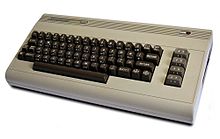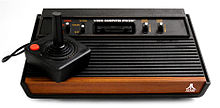Video game crash
As video game crash of economic collapse is video game industry in the United States designated between 1983 and 1985th Many American companies that made game consoles and home computers went bankrupt or were forced out of the market. This also represented the end of the economic success of the so-called "second generation" of the video game market, as exemplified by the decline of the industry pioneer and long-term market leader Atari, Inc.
For the next two years, the American video game market stagnated. This period only ended with the release of the Nintendo Entertainment System (NES) and the very successful video game Super Mario Bros. The device was first released in Japan in 1983 under the name Famicom , and finally appeared in the USA in 1985, where sales were high in 1987 . Japanese manufacturers such as Nintendo , Sega and later Sony dominated the console hardware market in the years that followed.
In some sources, this event is also referred to as the video game crash of 1984, since it was only in that year that the extent of the collapse became visible to the consumer. Hundreds of announced games were no longer on the market because of the bankruptcy.
Europe and Japan
In Europe, the early days of the home computer began between 1981 and 1985, making it possible for private individuals to own their own computer for the first time at an affordable price. This development was massively supported with advertising for such computers, especially for the Commodore 64 , which became the best-selling computer in many European countries.
Parents were faced with the choice of buying a game console or a computer that could teach most teenagers something useful. The graphics and sound capabilities of home computers were now comparable or even better than those of game consoles, and they offered better possibilities for copying the games. In addition, the games for home computers were much more attractively priced.
At the time of the North American collapse, the European market was clearly dominated by games for home computers, and the collapse had hardly any impact in Europe. Similarly, the events also led to a growth in the home computer market in the USA.
In Japan, the events also had no effect, as this market was independent of the European or American market: Most computers and video consoles from this country were purchased there, including the Famicom console from Nintendo, the Sega SG-1000 and the MSX computers.
History and triggers
The North American video game market collapse had several causes:
- A large number of different video game systems gave the buyer too much choice of incompatible systems: Atari 2600 , Atari 5200 , Bally Astrocade , Colecovision , Coleco Gemini , Emerson Arcadia 2001 , Fairchild Channel F System II , Magnavox Odyssey 2 , Mattel Intellivision , Intellivision II , Sears Tele-Games systems, Tandyvision and Vectrex . Each of these consoles had their own game library from the actual manufacturer and from other vendors. At the same time, some of these console manufacturers announced new versions of their game consoles for 1984. B. the Odyssey 3 or the Atari 7800 .
- Many low-quality games have been brought onto the market by a wide variety of game providers. At the same time, Atari published games that were based on well-known feature films (e.g. ET ) or successful arcade titles (e.g. Pac-Man ), but were of poor quality in the implementation, which the buyers quickly noticed.
- The media, which had reported on the video game industry in the previous successful years, made the weaknesses and problems an issue in 1982 and 1983. In particular, the destruction of millions of unsold ET games by Atari in the desert of New Mexico became a chilling example of the press.
- At the beginning of the 1980s, inexpensive computers came onto the market that could also be connected to the domestic television set as a monitor and that were equipped with color graphics and corresponding tone generators. Since all of these home computers offered more memory and often better graphics and sound quality than video consoles and at the same time the computers could not only be used for games, but also for word processing and other applications, home computers had an advantage over video consoles. The games were also far easier to copy there.
- The Commodore company specifically targeted the difference between home computers and video consoles with its advertising - the message was that children would need a home computer rather than a video console. Commodore and other companies sold their computers in department stores, supermarkets, and toy stores where game consoles had previously been sold. By producing the chips in-house, Commodore was also able to reduce production costs and thus the final price.
Beginning
The first step into the crisis was the founding of the company Activision , which was founded in 1979 by former Atari programmers David Crane , Larry Kaplan , Alan Miller and Bob Whitehead . The programmers had left Atari because the management refused to allow them to be named in the games they had developed. Activision mainly developed games for Atari's successful home console Atari 2600. Since Atari's point of view, other providers were not allowed to develop games for their console, Atari sued the new competitor, but lost this case in 1982. The court's decision allowed games from other manufacturers, so that countless companies founded video game departments in order to jump on the Atari success story with the Atari VCS 2600 .
The companies began to poach the programmers for these games from one another or to obtain the necessary know-how through reverse engineering . Despite Atari's experience, Mattel continued to hide the names of its developers, and in an interview with TV Guide magazine on June 19, 1982, even called for the names of Gabriel Baum , Don Daglow , Rick Levine , Mike Minkoff and John Sohl to be changed on purpose .
Direct effects on the market
The flooding of the market with many low-quality games from 1982 onwards had a destabilizing effect. When the dealers tried to return the unsaleable products to the game makers, it turned out that they had neither new, acceptable titles nor money. This led to a breakdown for many manufacturers. After the Christmas business in 1982, stores were forced to sell the games at significantly reduced prices.
All of these developments led to a large wave of bankruptcies in the market. Companies like Magnavox and Coleco closed their video game divisions. Imagic postponed its IPO the day before it should have happened and later also went bankrupt. The largest manufacturers such as Activision had also developed programs for the home computer market and stayed on the market, while the smaller providers mostly disappeared.
Long-term effects for the market
The collapse of the American video game market had long-term effects. The focus of the console market shifted from the USA to Japan. When the market recovered in 1987, the leading manufacturer of video game consoles was Nintendo with its NES, followed by Sega in second place. Atari too could not really recover and build on the success of the Atari 2600. In 1984 the company was split up because of the massive losses and the game console and home computer division was sold to Jack Tramiel , who continued the business as Atari Corporation . In 1996, however, the company finally ceased operations after the Atari Jaguar flop , and the brand name was resold. The arcade games, however, continued as Atari Games , renamed Midway Games West in 1998 after several changes of ownership and closed in 2003.
Web links
- The Dot Eaters: The Great Video Game Crash - End Game , accessed June 2, 2013. Translation by 8bit Museum, accessed June 2, 2013.
- Spiegel Online: Game Crash 1984: When ET Killed Video Games , March 10, 2009.
- Chris Crawford (former game developer at Atari) at Ersamatazz: The History of Computer Games: The Atari Years , accessed November 4, 2013
- Ken Polsson: Chronology of the Commodore 64 Computer (English), as of February 18, 2013.
Individual evidence
- ↑ COMPUTER: Business is war . In: Der Spiegel . No. 50 , 1984 ( online ).
- ↑ http://www.gamasutra.com/view/feature/129961/the_history_of_activision.php
- ↑ Archived copy ( Memento of the original from September 7, 2012 in the Internet Archive ) Info: The archive link was inserted automatically and has not yet been checked. Please check the original and archive link according to the instructions and then remove this notice.
- ↑ http://www.intellivisionlives.com/bluesky/people/tvguide.html



